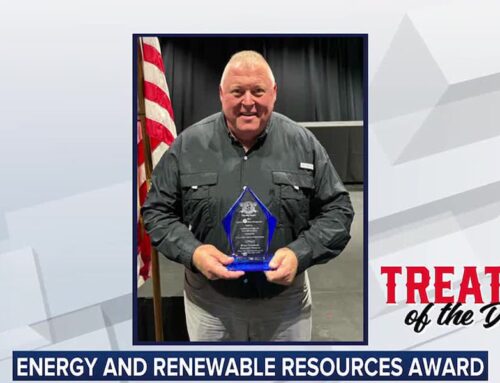New Mexico Democrat’s Ad Signals Shifting Politics On A Clean Energy Controversy
October 25, 2024
If power lines are the veins of the electrical system, big transmission lines that cross state and national borders are the major arteries ― and they’re notoriously hard to get approved.
In 2021, voters in Maine sided with fossil fuel companies on a referendum to block construction of a transmission line connecting Québec’s hydroelectric system to New England’s gas-burning grid. The next year, New York’s public utility regulator faced fierce opposition to a pair of transmission lines connecting New York City to solar and wind farms upstate and to Quebec’s zero-carbon grid.
Now, building a giant, locally-contested transmission line is something a Democrat is trying to run on.
In a 30-second TV spot released this week, Sen. Martin Heinrich (D-N.M.) calls the SunZia project — a controversial wind and transmission project, stretching 550 miles from New Mexico to regions in California to Arizona, that struggled for 20 years to get final approvals — “a game changer” that he’s proud to have gotten done.
“Decades in the making, the largest clean energy project in American history, right here in New Mexico,” Heinrich says in the ad. “Some said it was impossible, but I pushed it through. I believe in this country’s ability to build big things again – manufacturing, construction, transmission.”
It’s part of a shift among Democrats away from a mode of environmental politics that primarily seeks to stop construction of large projects. Instead, to wean the nation off fossil fuels, they’re embracing once-taboo solutions like nuclear power, lithium mining for batteries and denser housing.
That also now includes giant power lines, said Rob Gramlich, the president of Grid Strategies, a Washington, D.C.-based consultancy focused on transmission infrastructure.
“There’s a shift on transmission because awareness is growing pretty significantly about its benefits and necessity,” he said.
As a result, he said, those who want to cut U.S. climate-changing emissions are turning against the old not-in-my-backyard mentality.
“In the Democratic Party, NIMBY opposition is becoming less cool than … welcoming of development to get better population density, lower-cost housing and clean energy,” he added.
For much of the past three decades, U.S. electricity demand has remained flat, thanks in part to improvements in energy-efficient appliances. The country barely built any new transmission lines. But extreme weather and surging electricity demand from air conditioning, internet data centers and electric vehicles are putting pressure on the aging grid right as dependable coal and nuclear plants are shutting down. The average amount of time Americans spend in blackouts each year has more than doubled in duration over the past decade.
“Energy security concerns have reached this boiling point where we have to get real about solutions for the grid,” said Danielle Russo, the executive director of the Center for Grid Security at Securing America’s Future Energy, a Washington, D.C.-based nonprofit advocating for domestic energy projects. “Many more people are realizing we can’t have a conversation about real solutions for the grid without transmission being part of that conversation.”
Renewable power sources like wind turbines and solar panels offer one of the cheapest and swiftest ways to produce electricity without generating carbon emissions that further raise global temperatures and destabilize the Earth’s weather patterns. But solar and wind farms require vast areas of land often far away from population centers. The expansion of renewable power will depend on new transmission lines.
Heinrich – who, along with Sens. Brian Schatz (D-Hawaii) and Sheldon Whitehouse (D-R.I.), calls himself one of the Senate’s “three climateers” ― has long supported expanding the grid. And that doesn’t appear to have turned off voters: The Democrat has a double-digit lead in polls over his Republican challenger, Nella Domenici.
Momentum is now growing in Washington. The Federal Energy Regulatory Commission recently finalized a rule requiring grid operators to begin planning for long-term transmission needs that were previously left to the whims of the market.
Last year, House Democrats proposed a bill to ease permitting requirements on transmission lines in a bid to speed up development and get more of the country’s long-languishing projects underway. Much of the legislation was absorbed into the hotly-debated permitting reform bill Sens. Joe Manchin (D-W.Va.) and John Barrasso (R-Wyo.) introduced, which supporters hope could pass in a lame-duck session following next month’s election.
Environmental groups and progressive lawmakers have opposed permitting reform that also relaxes rules on fossil fuel infrastructure. But Gramlich said “almost every Democrat, if not all Democrats, support the transmission part of that bill.”
“That’s an indication of a shift,” he said. “I’m not sure that would have happened five years ago.”
What motivates the embrace of transmission lines, Gramlich said, is “just greater awareness.”
“The country barely built any transmission for about 30 years,” he said.
“Now a lot of people recognize it’s critical for clean-energy development and a lot of people and policymakers are starting to realize that we suddenly have power demand growth after a couple of decades without any,” he added. “We’re going to need expanded infrastructure. These things are starting to sink in.”
Search
RECENT PRESS RELEASES
Related Post




